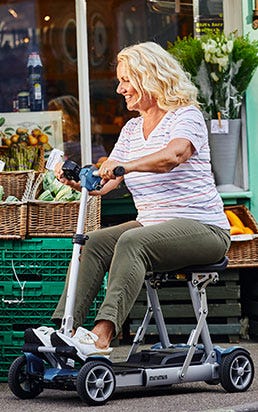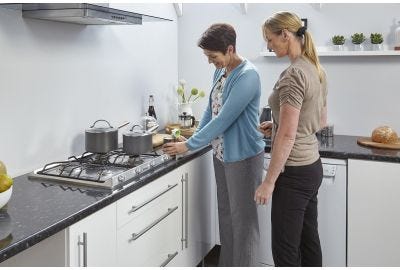Last year, I wrote a post about how I adapt my non-adaptive bathroom, as somebody with a fluctuating chronic illness. Today, I thought I’d use that same approach and share how I’ve adapted my kitchen too.
First of all, it’s important that I once again acknowledge my privilege in being able to live independently in a non-adapted property. However, I will say that it isn’t without its challenges – especially when it comes to energy-draining activities like cooking and cleaning.
While I won’t be focussing specifically on cooking this time, in this post I wanted to share some of the ways I’ve adapted my kitchen environment to better suit my needs…
Perching Stool
It’s no secret that many of us with chronic illnesses have difficulty standing for long periods of time, and that includes the time it takes to cook and prepare food.
My kitchen is quite small, and I don’t own a table and chairs (perfect excuse for sofa dinners in front of the TV, if you ask me….), but I have a stool nearby which I can easily move to wherever I need it.
There are all kinds of perching stool models out there, and they don’t necessarily have to be designed as mobility equipment to do the job: my stool was just from a budget store and is the same height as my counter top, meaning it’s no hassle to perch on there while I’m getting things done.
The real challenge for me is remembering to sit down before it’s too late and my legs have turned to jelly. We can’t be having that.
Strategically Arranged Cupboards
It never fails to amaze me how much kitchen equipment one person can accumulate. Within weeks of moving into my flat back in 2018, my cupboards seemed to be full to the brim (first world problems, I know), and any time I needed to find anything, it turned into something of a scavenger hunt.
It’s tricky to describe exactly what I mean here, but over the years I’ve learned to find homes for equipment strategically, grouping together the different things I’m likely to need at the same time. It might seem small, but any little thing that can reduce the number of steps you need to take back and forth to get out and put away the things you’re using can really help you to conserve energy and reduce pain.
As an example, I have an absolutely untouchable cup of tea routine. My mugs and teabags which, let’s be honest, I reach for more times per day than anything else in my kitchen, are both stored together in the cupboard that’s most comfortably reachable for me.
That cupboard is located right next to the cutlery drawer where I go for my teaspoon, conveniently picking up my oat milk from the fridge along the way. That means I only need to take a couple of steps in total to get everything I need and put the kettle on, without faffing about going back and forth, and I can easily reach the pivotal biscuit jar from there too.
Solid routine. If you too are a fellow tea enthusiast, you could even go one metaphorical step further and get yourself a kettle tipper to make those cuppas easier to pour.
Aids And Equipment
Often, it’s easy to forget just how many different types of aids and equipment exist to make life easier for disabled people – and kitchen equipment is no exception.
There are now Ring Pull Can Openers, the Kitchen Genie, and even Arthritis Friendly Cutlery Sets designed to be more comfortable for people with limited hand grip. Anybody who knows me will tell you I’m comedically bad at getting the lids off bottles.
I wish I could blame it entirely on my disability, but the fact of the matter is that I’ve just never got the hang of it… and since acquiring my chronic illness, my hands and arms have become even more uncooperative. However, midway through writing this post I stumbled across the Multi-Grip Jar And Bottle Opener, and I really think I might have to get myself one.
It seems like the idea solution for my lid-related angst, and anything that speeds up the process of getting yourself a soft drink when you’re craving one more than anything gets a solid 10/10 from me.
Noise-Reducing Tools
And finally, an adaptation that might seem odd to anybody who doesn’t have noise sensitivity, but arguably one of the most pivotal things for me.
One of my most debilitating symptoms is head pain, and any kind of ‘sharp’ noise (such as things slamming shut or objects hitting each other) causes pain to reverberate through my body. Because of this, I’ve had to be especially proactive in managing noise threats in the kitchen – the room with the most potential for catastrophe in this area.
During my university years, I discovered Transparent Protectors - tiny little bubble stickers that can go on the edges of cupboards or drawers. They’re designed to protect surfaces, but I also found they slightly reduce the impact and stop them from slamming quite as loudly when they’re opened or closed.
They’re not miracle workers by any means, but if you too struggle with noise sensitivity, they might make a difference to you too. However, there are of course some things where sharp noises are just unavoidable, and for these (don’t laugh), I put my noise-cancelling headphones on. More often than not, it’s essential that I have those headphones on my head before I begin unloading the dishwasher (another tool I heavily rely on) and putting my stuff away.
I know full well that might seem ridiculous or excessive to some, but it makes a world of difference to my condition management and offers the perfect excuse to whack a podcast on at the same time. Everybody wins!
Do you adapt your non-adaptive kitchen? I’d love to hear any of your own tips and tricks – you can find more from me at Life Of Pippa, and join in the conversation on social media over at @lifeofpippa. Thanks for reading!


 Price Match Promise
Price Match Promise
 Next day delivery, 7 days a week
Next day delivery, 7 days a week
 Nationwide Showrooms
Nationwide Showrooms
 Rated Excellent
Rated Excellent








